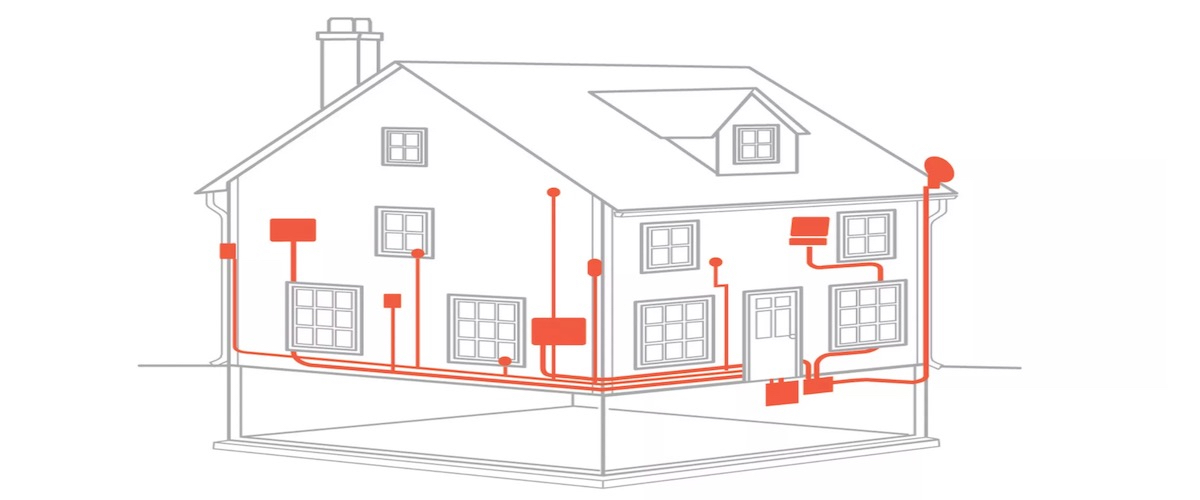Rewiring a House: 5 Steps and Professional Tips
Upgrading the electrical system is a common need amongst house owners, especially if it is a historic home or an older house. When these were built and first wired, there weren’t as many appliances and electronics. So chances are that the wiring system is either outdated or undersized.
Due to the fact that rewiring a house is quite the financial undertaking, not to mention messy and complex, a common question that electricians get asked all the time is “Can you rewire a house in stages?” Theoretically, it is possible to do this bit by bit, but there are many reasons why you shouldn’t:
- You’ll need to leave the old cables in place – because you’re not doing the entire house at the same time, you’ll have to leave the new cables on the reel until the next area is ready for rewiring, to connect all of them up to the board, sockets and switches at the end, and thus still keep the old cables in place.
- Junction boxes will need extra room – since you’re keeping both the old cables and the new ones, the junction box needs to have the extra room to accommodate that. If there is no room, then you’ll need to leave the new cables out, which means there will be a patch to fill later.
- It will end up costing more – you may only pay for one room or one area at a time, therefore costing you less in the moment, but there will be extra work and visits for the electricians and possibly the decorators, so in the end you’ll end up paying more.
That said, there are a few steps one can take to ensure a smoother process, which may result in less time, as well as the safety of the house and everyone in it. In the end, upgrading your electrical system may even save you money on electrical bills, so it’s definitely worth taking it on. Here are 5 steps to help you get through the process comfortably and safely.
1. Make a Plan
Rewiring a house can be a very complex process, especially if your home was built before 1980 and features a 60-amp panel. The same applies if your usage is generally high, or the size of your house is bigger than average. All of these factors influence whether or not it’s just the cables that need replacing or the electrical panel, also known as breaker box, as well.
Doing an electrical inventory of your home will help you assess some of these factors. You can start by making a list of all the appliances and electronics in the house and where you’re using them. Include light fixtures in the inventory as well, not just devices like TVs, refrigerators and computers or game consoles. The inventory should also help you identify any extra needs or future wishes, such as additional lighting in the kitchen or the bedroom, installing a hot tub or spa, or buying a treadmill.
Evaluate your usage based on the inventory and take this opportunity to research local codes and any permits that may be needed. Then, you can simply draw your home and include the items on your inventory, like major appliances, electronics, lights, switches, and receptacles. This type of visual representation will help the electrician plan the home’s electrical circuits based on your goals.
Pro Tip: Have an electrician review your drawing to ensure safety and practicality. It’s always more expensive to make changes once the work has started.
2. Decide How to Rewire the House
If you’re looking to modernize your home, there are several options now for modern wiring that carries not only electricity, but also fire, data and security too. You should look into wiring systems that function in multiple ways.
Today, wireless systems are becoming more and more affordable, as well as more sophisticated, so they might just make your life easier. Talk to your electrician beforehand, in order to properly prioritize your needs.
Another aspect you should decide before the work starts is where to start. Rewiring a house usually has two stages:
- Replacing – this first stage refers to the replacements of all cables, wires, circuits and mounting boxes.
- Installing – this second stage refers to the installation of lighting fixtures, switches and faceplates on receptacles.
Because you won’t have electricity to all areas during the rewiring, deciding where to start can impact whether you’ll be able to live in your home or not. The work can take anywhere from 3 days to entire weeks, depending on the complexity of the projects and your requirements.
Pro Tip: Be prepared for disruption, as rewiring a house oftentimes involves lifting carpets and floorboards, or opening up walls and ceilings. How long it takes to rewire the house ultimately depends on the existing wiring system and your new plan.
3. Set a Budget
Setting a budget when rewiring a house is essential, not only because you will be able to make decisions quickly, but also because it will allow you to consider all aspects, and plan for the inevitable. The cost to rewire a house depends on the electrician you hire, the size of your house, the specific requirements you have, as well as the inevitable demolition and reconstruction that ensues.
Pro Tip: Reduce spending by taking on some of the preparation or cleanup yourself, but don’t cut costs with materials. Cheap materials will not make your system work safely and efficiently for 25 years.
4. Get the Updated Electrical Plan in Writing
You may have discussed your electrical inventory and your requirements with the electrician, but before any work starts, make sure you get the update plan in writing. This will help not only with the price estimate, but also to ensure that nothing has been overseen or left out.
Having the plan to refer back to is also a good way to address any issues that may arise. In fact, just by writing down the rewiring plan, one can prevent problems before they even crop up. However, it’s good to keep in mind that very often, after the work starts, electricians might run into problems they couldn’t have predicted.
Pro Tip: After seeing the written rewiring plan and the cost estimate, allow for a slush fund for any unforeseen issues that may arise.
5. Get a Residential Electrician with Considerable Experience
Rewiring a house is not a job for your local handyman. You need a certified electrician, preferably with 10+ years of experience in the field. Be sure to check their license and certifications.
The expertise and experience of your electrician are important for every step, not just the actual work being done. As said, they should be able to help with your electrical inventory and plan, make suggestions and changes, and lead you towards the best rewiring option for your home. The last thing you want is an inexperienced electrician causing damage to your house or, worse, putting you and your family’s life in danger.
Pro Tip: Look for electricians who carry both an electrical contractor license and a Journeyman’s electrician license.





